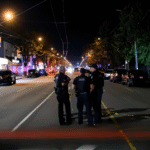Storm Eowyn, a once-in-a-generation weather phenomenon, has wreaked havoc across Ireland, leaving over 715,000 homes and businesses without power. With record-breaking winds and widespread damage, authorities are warning that the worst is not yet over. This article explores the devastating impact of Storm Eowyn and provides essential updates on the situation.
Storm Eowyn Causes Record-Breaking Winds Across Ireland
Storm Eowyn has shattered weather records in Ireland, with gusts reaching a staggering 113 mph (183 km/h) in Mace Head, County Galway. This surpassed the previous high of 182 km/h recorded in 1945 in County Limerick. Additionally, the mean wind speed record was broken, with 84 mph (135 km/h) recorded at Mace Head, exceeding the 81 mph (131 km/h) set in 1945.
These extreme winds have caused significant damage to infrastructure, with power lines downed and trees uprooted across the country.
Over 715,000 Without Power Due to Storm Eowyn
The Electricity Supply Board (ESB) has described the widespread power outages caused by Storm Eowyn as “unprecedented.” As of Friday morning, more than 715,000 homes, farms, and businesses are without electricity, and further outages are expected as the storm intensifies.
The ESB has warned that it could take up to a week to fully restore power, given the extent of the damage to the electricity network.
Public Safety Measures Amid Storm Eowyn
Authorities have issued red weather alerts for much of Ireland, urging people to shelter indoors and avoid unnecessary travel. Keith Leonard, chair of the National Emergency Coordination Group, called Storm Eowyn one of the most dangerous storms in recent history.
“We expect this storm to be destructive, dangerous, and disruptive,” Leonard stated. “The winds could exceed 130 km/h inland, posing a severe risk to life and property.”
The public has been advised to:
- Stay indoors and avoid coastal areas.
- Fully charge phones, torches, and other essential devices.
- Secure loose outdoor items to prevent them from becoming projectiles.
Disrupts Transport and Daily Life
Travel across Ireland has come to a standstill as Storm Eowyn continues to batter the country. Major airports, including Shannon, have canceled flights, while public transport has been suspended during the storm’s peak hours. Roads are littered with fallen trees and debris, making driving hazardous.
Schools, parks, offices, and businesses remain closed as authorities work to mitigate the storm’s impact.
Comparisons to Past Storms
Storm Éowyn has already surpassed the destruction caused by Storm Ophelia in 2017, which left 385,000 properties without power. Some are comparing the storm to Hurricane Debbie, the deadliest storm in Irish history, which caused 24 fatalities in 1961.
While Storm Eowyn has not reached the fatality levels of Hurricane Debbie, its impact on infrastructure and daily life is unmatched in modern times.
Long-Lasting Impact
The effects of Storm Eowyn will be felt for days to come as emergency services work to restore power, clear roads, and support affected communities. The public is urged to remain vigilant and follow updates from authorities to stay safe during this dangerous weather event.
As Ireland faces the aftermath of this devastating storm, the resilience and preparedness of its people will play a critical role in recovery. Storm Eowyn serves as a stark reminder of nature’s power and the importance of taking severe weather warnings seriously
Also Read- Cyclone Chido Strikes Mayotte
Top 5 FAQs About the Severe Storm
Which areas are most affected by the storm?
Coastal regions, particularly Galway, have been severely impacted, with gusts reaching 113 mph. Northern Ireland and parts of the UK are also experiencing significant effects.
What is this storm, and why is it significant?
This powerful storm, with record-breaking winds of 113 mph, has caused widespread damage, major power outages, and severe travel disruptions across Ireland. Its intensity makes it highly notable.
How many people have been affected by the storm?
Over 715,000 homes, farms, and businesses in Ireland are currently without electricity. Restoration efforts are ongoing, but it may take up to a week to fully restore power.
What safety measures should I take during a severe storm?
To stay safe, remain indoors, avoid unnecessary travel, secure loose outdoor items, and ensure essential devices like mobile phones and flashlights are fully charged.
How does this storm compare to previous storms?
This storm has surpassed Storm Ophelia (2017) in terms of power outages and broken wind speed records that had stood since 1945, making it one of the most destructive storms in Irish history.










